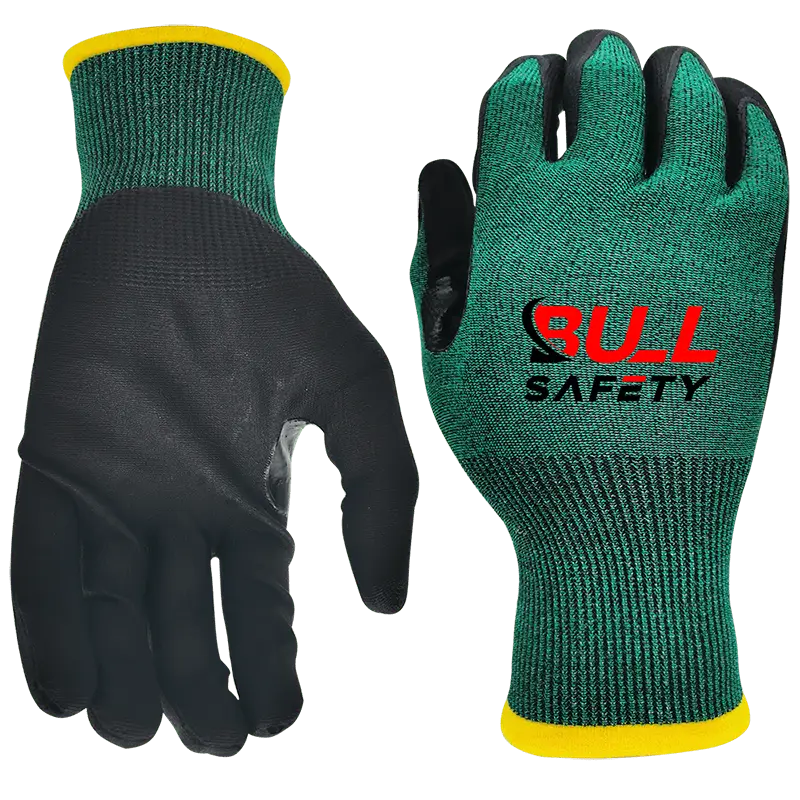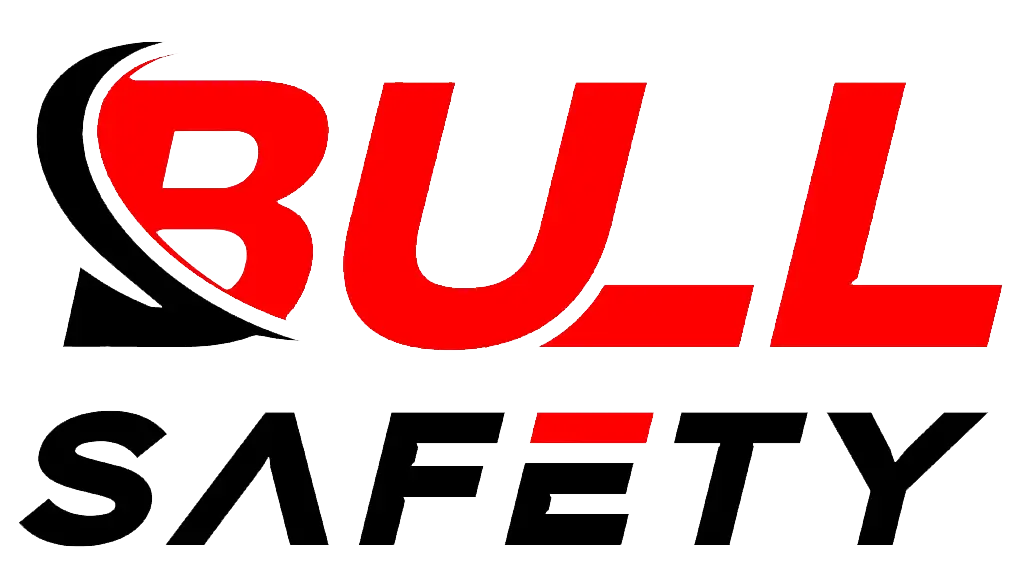
Bullsafety 18gauge A2 4X42B microfoam palm coated gloves
When selecting gloves for workplace safety1, I always prioritize cut resistance2 to protect against sharp objects. But not all gloves offer the same level of protection. Here’s a complete guide on cut-resistant gloves3, including materials, certifications, and the best options for different tasks.
What Type of Gloves Are Cut Resistant?
✅ Cut-resistant gloves, made from Kevlar, HPPE, or stainless steel mesh, offer different protection levels (ANSI A2-A94, EN 388) to prevent injuries in manufacturing, construction, and metalworking.
Cut-resistant gloves are not one-size-fits-all. They come in different materials and levels of resistance, depending on the work environment and safety standards.
Cut Resistance Levels (ANSI A1–A9 & EN 388)
| ANSI Cut Level | Use Case | Example Gloves |
|---|---|---|
| A1 – A2 | Light-duty work (Packaging, Warehouse) | PU-Coated Gloves |
| A3 – A4 | Moderate risk (Assembly, Construction) | HPPE Gloves |
| A5 – A7 | High risk (Metal Fabrication, Automotive) | Kevlar Gloves |
| A8 – A9 | Extreme risk (Glass Handling, Heavy Metalwork) | Steel Mesh Gloves |
🔗 Read more about ANSI cut levels here
💡 Tip: Always check the glove’s EN 388 rating5 for abrasion, cut, tear, and puncture resistance before making a decision.
Do Cut-Resistant Gloves Really Work?
Many people wonder, “Are cut-resistant gloves really effective?”
✅ Yes, when chosen correctly based on ANSI and EN 388 ratings6, cut-resistant gloves significantly reduce injury risks. However, they are not puncture-proof and should be paired with reinforced gloves for high-risk environments7 like metalworking or glass handling.
Key Factors That Affect Performance
| Factor | Impact on Protection | Example Materials |
|---|---|---|
| Material Strength | Strong fibers provide high cut resistance. | Kevlar, HPPE, Dyneema |
| Coating Type | Improves grip and durability. | Nitrile, PU |
| Proper Certification | ANSI or EN 388 ensures tested protection. | ANSI Cut Level A5 |
Common Misconceptions About Cut-Resistant Gloves
❌ Not Puncture-Proof – These gloves protect against cuts but won’t stop punctures from needles or sharp tips.
❌ Wrong Size Reduces Protection – Loose gloves can slip off, and tight gloves limit dexterity.
❌ Lifespan Matters – Gloves wear out over time, and replacing them regularly ensures continued protection.
🔗 Browse cut-resistant gloves with ANSI certification
What Type of Gloves Does Not Protect Against Cuts and Burns?
Not all gloves are designed for cut and heat protection. Some gloves fail to protect against sharp objects and high temperatures.
✅ Disposable, cloth, and thin leather gloves offer little to no protection against cuts and burns. For safety, choose cut-resistant gloves with reinforced fibers (HPPE, Kevlar) or heat-resistant gloves for welding and high-heat tasks.
Gloves That Offer No Cut/Burn Protection
| Glove Type | Why They Fail | Better Alternative |
|---|---|---|
| Disposable Gloves | Tear easily, not reinforced | Nitrile-Coated Gloves |
| Cloth Gloves | No cut-resistant fibers | HPPE Cut-Resistant Gloves |
| Thin Leather Gloves | No cut or heat protection | Kevlar Heat-Resistant Gloves |
💡 Tip: If you need both cut and heat protection, choose Kevlar-lined gloves with heat resistance.
Which Gloves Prevent Cuts and Abrasion During Material Handling?
When handling rough or sharp materials, I look for gloves that offer a balance of cut resistance and flexibility.
✅ For material handling, coated gloves (nitrile, PU, latex) provide grip, abrasion resistance, and cut protection. PU-coated gloves are best for warehouse work, while nitrile-dipped gloves handle heavy-duty tasks.

Best Gloves for Material Handling
| Glove Type | Features | Best For |
|---|---|---|
| Nitrile-Coated | Oil-resistant, durable grip | Heavy-duty material handling |
| PU-Coated | High abrasion resistance, flexible | Warehouse, precision work |
| Latex-Coated | Strong grip, water-resistant | Construction, general handling |
How to Choose the Right Gloves for Material Handling
🔹 Check EN 388 Ratings – Look for abrasion, tear, and puncture resistance8.
🔹 Match to Work Conditions – Oil-resistant gloves9 for mechanics, PU-coated gloves10 for assembly.
🔹 Ensure Proper Fit – Loose gloves reduce grip strength and increase risks.
🔗 Find the best gloves for material handling here
Frequently Asked Questions (FAQs)
What Are the Different Cut Resistance Levels (A1-A9)?
ANSI cut levels range from A1 (lowest) to A9 (highest).
- A1-A2: Basic protection for light assembly
- A3-A4: Moderate protection for construction, packaging
- A5-A7: High protection for metal fabrication
- A8-A9: Extreme protection for glass handling, sheet metal
🔗 Read the full ANSI cut level guide
Are Nitrile-Coated Gloves Cut Resistant?
Nitrile alone is not cut-resistant, but nitrile-coated HPPE gloves offer both grip and cut protection.
Conclusion
Choosing the right cut-resistant gloves depends on certifications, materials, and the work environment. By considering ANSI & EN 388 ratings, coating types, and specific risks, I ensure my hands stay protected.
🔗 Shop ANSI-certified cut-resistant gloves now
-
Exploring this resource will provide you with essential strategies to enhance safety in your work environment. ↩
-
Understanding cut resistance measurement will help you choose the right gloves for your specific needs and tasks. ↩
-
This link will guide you to the best options available, ensuring you select gloves that meet your safety requirements. ↩
-
Understanding ANSI cut levels helps you choose the right gloves for your specific safety needs in the workplace. ↩
-
Learn about the EN 388 rating to make informed decisions on glove safety and performance standards. ↩
-
Learn about ANSI and EN 388 ratings to make informed choices when selecting cut-resistant gloves for safety. ↩
-
Discover high-risk environments where cut-resistant gloves are essential for safety and injury prevention. ↩
-
Understanding EN 388 ratings helps you choose gloves that ensure safety and efficiency in material handling tasks. ↩
-
Exploring the best oil-resistant gloves can enhance your safety and performance in mechanical tasks. ↩
-
Discovering the advantages of PU-coated gloves can improve your precision and comfort during assembly tasks. ↩



